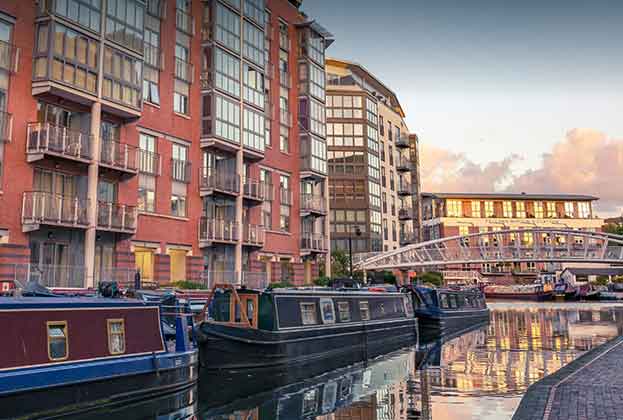How can Birmingham maximise its economic potential?
Filling the supply gap
There are increasing headwinds in the market, but a lack of supply suggests there are opportunities in multiple sectors
Birmingham has proven to be resilient in recent years, developing a more mixed economy with strength across a range of service and knowledge sectors. The 2022 Commonwealth Games showcased both the city’s rich history and its bright future as a major cultural and economic centre in the UK. The Government’s Levelling Up policy, now back on the agenda with the return of Michael Gove to DLUHC, should bring new opportunities and investment to the area, and act as a catalyst to boost economic productivity.
However, recent political turmoil and the rising cost of debt both pose challenges in the short term. Yet the market remains undersupplied across the residential, commercial and logistics sectors, and there is considerable potential for both development and investment once certainty begins to return to the market.

The office market
Office take-up in Birmingham between Q1 and Q3 2022 totalled 486,000 sq ft. Whilst this was 7% below the long-term average for the Q1–Q3 period, there remains cause for optimism with the Q3 total of 193,000 sq ft being 10% above the long-term Q3 average. 77% of 2022 take-up was Grade A quality, suggesting significant appetite for high-quality, well-connected office space.
However, there is now less than half a year of available prime Grade A supply in the market. The flight to quality combined with a shortage of supply has put upward pressure on prime rents. Rents have grown by 13% since 2019 with the top rent in the market currently standing at £39 psf. That being said, Savills is aware of ongoing deals that will surpass this figure in Q4, and we expect prime rents to reach £40 by the end of 2022.
The Banking sector has been the most active in 2022 so far, accounting for 24% of total take-up. This has been bolstered by the 110,000 sq ft letting to Goldman Sachs at One Centenary Way, which is due to complete in March 2023. Elsewhere, the Professional sector was the second most active, accounting for 23% of overall take-up. However, there are signals that occupiers in this sector are looking to take less space than they were previously occupying.
There is increasing demand beyond these traditional commercial occupiers. The city is still seeing strong growth in the tech sector. A recent government report recognised the region as a top performer for digital growth, with an additional 52,000 roles in the sector projected over the next four years – a bumper increase of 55% since 2019. The tech sector in the West Midlands grew by an average of 7.6% a year between 2014 and 2020, the fastest region in the UK. It is expected to generate at least £2.7 billion per year for the local economy by 2025.
Logistics
Looking beyond central Birmingham, demand for logistics space across the Midlands has grown significantly during the pandemic, and has remained robust despite increasing economic headwinds.
Take-up for the year to date in the West Midlands stands at 6.1 million sq ft, and the average deal size has increased by 53% over the last ten years to over 277,000 sq ft. Vacancy rates are at 2.3%, constraining occupiers' ability to expand their operations; Savills estimates that take-up in Birmingham could be up to 29% higher than current levels if sufficient space was available.
However, supply remains very constrained. The supply of space in the West Midlands over 100,000 sq ft is currently at 2.82 million sq ft. Based on the three-year average take-up, this is equivalent to less than half a year’s worth of supply. Furthermore, 32% of this supply is Grade C space, and is unlikely to be suitable for many occupiers without comprehensive refurbishment. Grade A rents were reaching £9.75 psf in H2 2022, and the shortage of new supply means we expect rents to continue to grow despite the current economic uncertainty.
The residential market
Since the end of the first lockdown, the UK housing market has boomed. Birmingham has seen price growth of 14% since March 2020, with the average home now sold for £257,000 – 42% above its 2007/08 peak. House prices are expected to fall in 2023 in response to rising interest rates, but the West Midlands should still see just under 10% house price growth over the next five years.
Despite this recent strong growth, the city has maintained its affordability advantage over comparable markets. With a median house price to income ratio of just 7.1 in 2021, compared to a national figure of 8.9 and 13.7 in London, Birmingham is well placed to attract a more skilled workforce looking for either central urban living or a larger family home in which to settle down. Birmingham’s improved transport links to the capital, combined with the increasing prevalence of working from home, make the ‘Second City’ ever more appealing.
Maintaining house prices at an affordable level relies on the delivery of new homes to ease competition in the sales market, and Birmingham is currently failing to deliver enough new homes. Annual housing delivery was just 68% of the Standard Method housing need figure over the five years to March 2021. The number of new homes built has fallen each year since 2018/19, and with the most recent housing land supply statement at 3.2 years, this trend is unlikely to rapidly reverse. Delivering new homes in larger numbers must be a priority for the city to maintain the crucial affordability advantage it currently possesses.
Read the articles within Birmingham: growth and productivity below.


